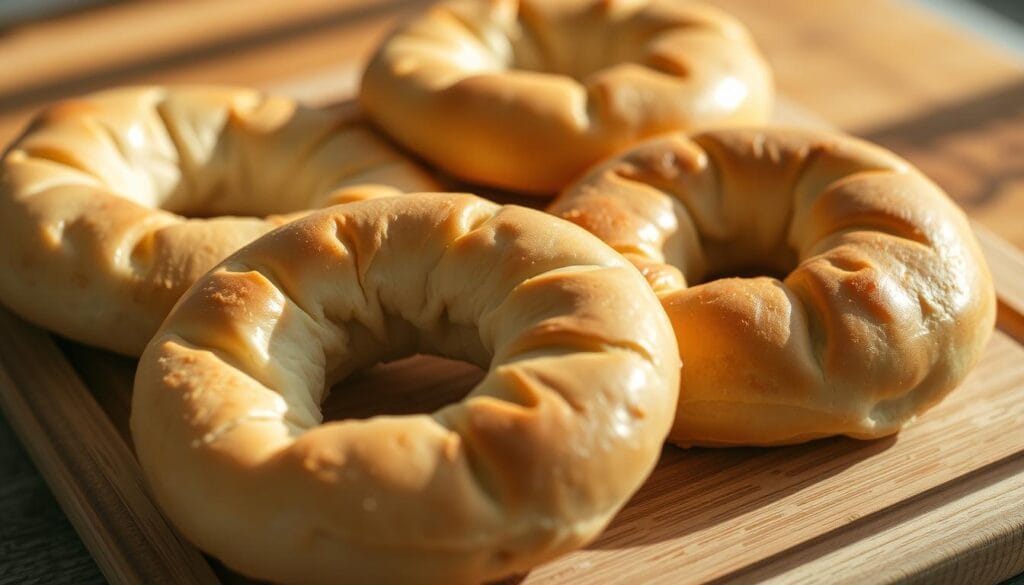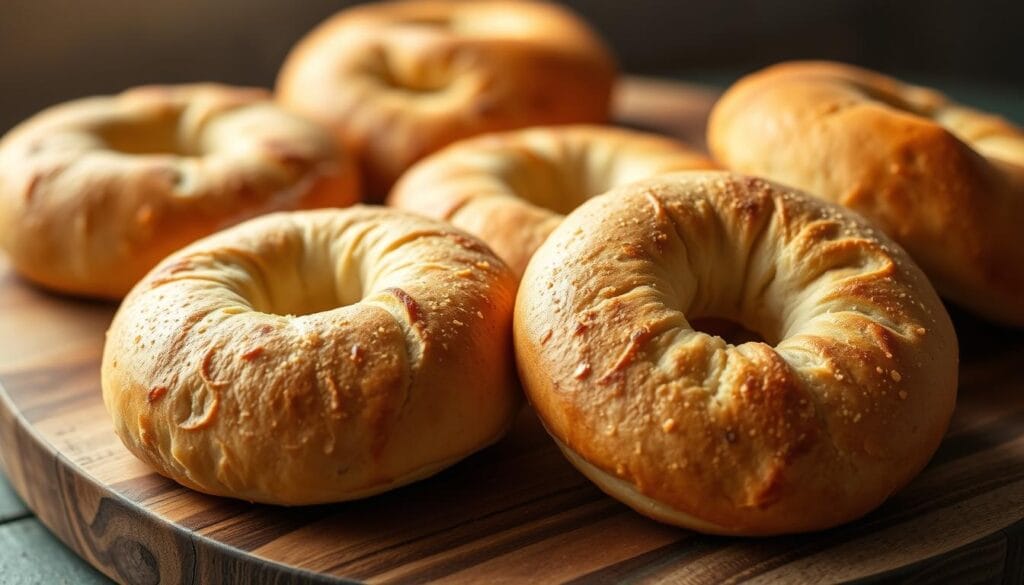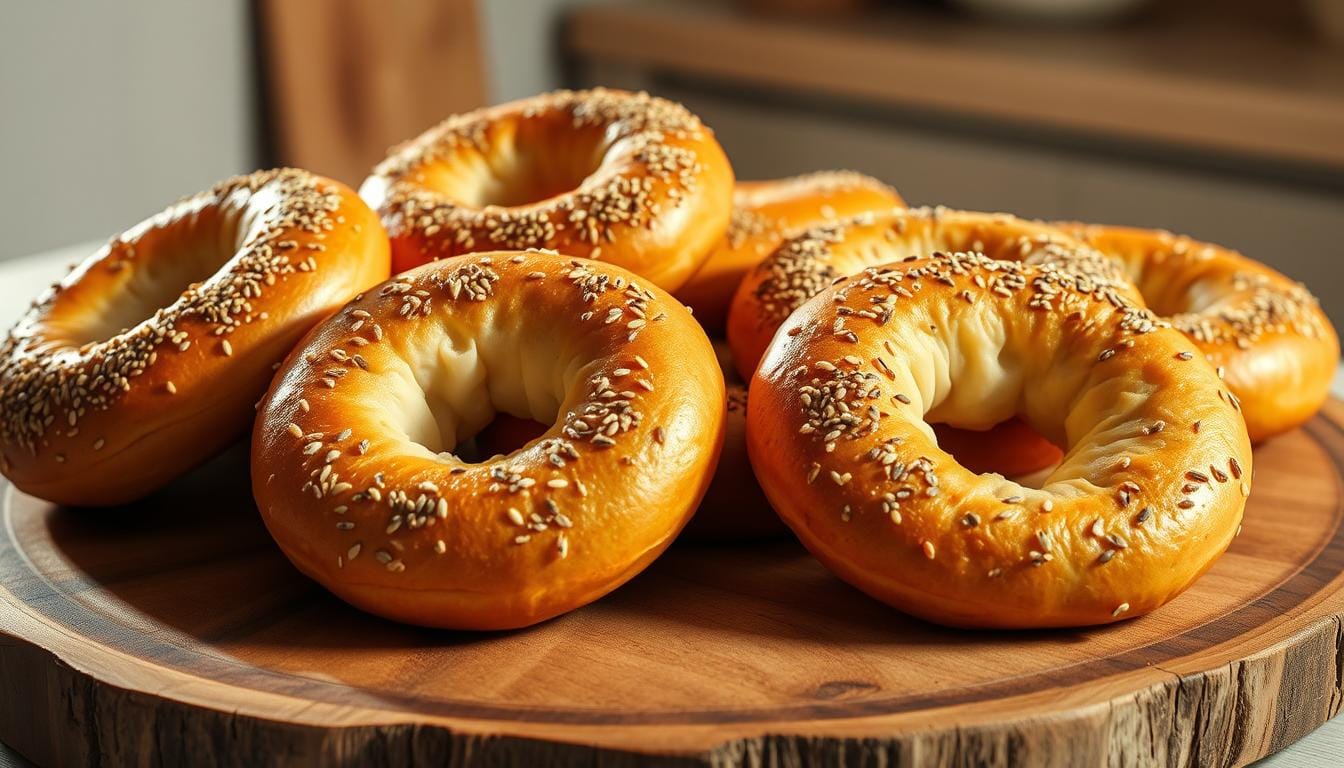Making gluten free bagels at home is a game-changer for those who love fresh bread but can’t eat gluten. With the right ingredients and a simple recipe, you can make tasty gluten-free bagels. They’re perfect for breakfast, lunch, or as a snack. We’ll explore gluten-free bagels, including the best ones and how to make them at home.
Imagine enjoying a warm, freshly baked gluten-free bagel, straight from your oven. It’s ready in under 40 minutes, and you can make 6 delicious bagels. Each bagel has about 216 calories, 40g of carbs, and 8g of protein. They’re a great quick and easy meal option.
Introduction to Gluten-Free Bagels
Gluten-free bagels are a great alternative to traditional bagels. With the right recipe, you can make the best gluten-free bagels at home. We’ll give you a simple recipe and tips for making delicious gluten-free bagels. They’re perfect for anyone with gluten intolerance or sensitivity.
Key Takeaways
- You can make delicious gluten-free bagels at home with a simple recipe and ingredients.
- The total time to make gluten-free bagels is under 40 minutes, and you can make 6 bagels at a time.
- Each bagel contains approximately 216 calories, 40g of carbohydrates, and 8g of protein.
- Gluten-free bagels are a great alternative to traditional bagels for those with gluten intolerance or sensitivity.
- You can store your gluten-free bagels for up to 3 days to keep them fresh.
- With the right ingredients and recipe, you can make the best gluten-free bagels at home.
Understanding Gluten-Free Bagels
Wondering where to find gluten-free bagels? Making your own at home is a smart choice. It lets you pick the ingredients and meet your dietary needs.
To make tasty gluten-free bagels, you need a gluten-free flour blend. You can find this at health food stores or online. Try mixing different gluten-free flours like almond, coconut, or rice to find your favorite.
Benefits of Homemade Gluten-Free Bagels
Homemade gluten-free bagels offer many advantages. You can pick the ingredients, avoiding gluten and allergens. You can also add your favorite flavors and textures, like sesame seeds or dried fruit.
They’re also cheaper than store-bought ones. Plus, you can make a lot and freeze them for later.
Common Challenges and Solutions
Getting the right texture is a big challenge with gluten-free bagels. They can be dense. To fix this, add xanthan gum or psyllium husk. These help with texture and structure.
Try different rising times and temperatures to find what works best for you.
With practice and patience, you can make great gluten-free bagels at home. They’re perfect for toast, sandwiches, or snacks. So, why not try making your own and see what you can create?
Essential Ingredients for Perfect Gluten-Free Bagels
To make perfect top rated gluten free bagels, you need the right ingredients. A good gluten-free flour blend is key for structure and texture. Instant yeast is also important for making the dough rise and giving it a light texture.
You’ll also need sea salt, sugar, and xanthan gum (if your flour blend doesn’t have it). Warm milk is needed to activate the yeast and make the dough smooth and elastic. For an egg wash, you’ll need an egg. For the boiling mixture, you’ll need sugar, baking soda, and water.
Here are the essential ingredients you’ll need:
- 2 cups of all-purpose gluten-free flour
- 1 teaspoon of instant yeast
- 1 teaspoon of sea salt
- 2 tablespoons of brown sugar
- 1 teaspoon of xanthan gum (if necessary)
- 1 cup of warm milk
- 1 egg (optional)
Using these ingredients, you can make healthy gluten free bagels that taste great and are good for you. With the right ingredients and a bit of practice, you can make perfect gluten-free bagels at home.
Required Kitchen Equipment and Tools
To make delicious gluten-free bagels, you’ll need some basic kitchen equipment and tools. Having the right tools makes the process easier and more efficient. You can explore various gluten free bagel options by investing in a few essential items.
When it comes to making gluten-free bagels, the type of equipment you use can affect the final product. For instance, using a stand mixer can help you mix and knead the dough more effectively, resulting in a better texture. On the other hand, a pastry brush can be useful for applying egg wash or water to the bagels before baking.
Basic Equipment Needs
The basic equipment needs for making gluten-free bagels include a mixing bowl, a measuring cup, and a baking sheet. You’ll also need a spatula and a pastry brush. These tools will help you mix, knead, and shape the dough, as well as bake the bagels to perfection.
Optional but Helpful Tools
Some optional but helpful tools for making gluten-free bagels include a stand mixer and a dough scraper. A stand mixer can help you mix and knead the dough more efficiently, while a dough scraper can be useful for scraping the dough off the counter and into a bowl. These tools can help you achieve better results and make the process more enjoyable.
By investing in the right kitchen equipment and tools, you can create delicious gluten-free bagels that are perfect for any occasion. Whether you’re looking for a tasty breakfast or snack, gluten-free bagels are a great option. With the right equipment and a little practice, you can become a pro at making gluten-free bagels and enjoy the many benefits of gluten-free bagel options.
Choosing the Right Flour Blend
Choosing the right flour blend is key to making the best gluten free bagels. There are many options, making it hard to pick just one. Recent tests show Cup4Cup Multipurpose Flour is the top choice, making bagels that taste like the real thing.
Cup4Cup’s secret is its mix of cornstarch, tapioca starch, and potato starch. These ingredients help the dough stick together and keep it moist. Brown rice and white rice flour add protein and starch, making the bagels flavorful and textured. Xanthan gum is added to give the bagels a springy feel, essential for gluten-free baking.
Some key features of Cup4Cup Multipurpose Flour are:
- Contains a blend of starches for improved texture and structure
- Includes brown rice flour and white rice flour for balanced protein and starch content
- Features xanthan gum for added elasticity and springiness
- Priced at $17 for a 3-pound bag, offering a cost-effective solution for gluten-free baking
By picking the right flour blend, you can make delicious gluten free bagels. Cup4Cup Multipurpose Flour gives you a puffy, golden, soft, and chewy texture. It’s perfect for those wanting to make the best gluten free bagels at home.
The Science Behind Gluten-Free Bagel Making
Gluten-free bagel making involves understanding some key science. This includes looking at protein content, xanthan gum, and temperature. By focusing on these, you can make gluten-free bagels that are just as tasty as the traditional kind.
Protein content is a big deal in gluten-free bagel making. Gluten-free flours don’t have the same protein as wheat flour. This can change how the bagels turn out. To fix this, mix different gluten-free flours with different protein levels.
Xanthan gum is also very important. It makes the dough stronger and improves its texture. This helps the bagels rise better and gives them a chewier inside. Adding xanthan gum makes gluten-free bagels taste more like the real thing.
Temperature is another key factor. The best temperature for proofing and baking depends on your recipe. But, a warm, draft-free spot is best for proofing. A hot oven is needed for baking. This helps make the bagels crispy on the outside and soft on the inside.
Here are some key things to remember for gluten-free bagel making:
- Use a mix of gluten-free flours with different protein levels
- Add xanthan gum to make the dough stronger
- Control the temperature for proofing and baking
Understanding the science behind gluten-free bagel making lets you make tasty gluten-free bagels. You can make everything bagels or try new flavors. The right techniques and ingredients will help you succeed.
Step-by-Step Mixing and Kneading Process
To make top rated gluten free bagels, follow a detailed mixing and kneading process. This is key to creating healthy bagels that taste great and have the right texture. Begin by mixing 3 ½ cups of bread flour, 1 ½ teaspoons of fine-grain sea salt, 4 ½ teaspoons of granulated sugar, and 2 teaspoons of active dry yeast in a large bowl.
Then, add 1 ¼ cups of warm water to the dry ingredients. Mix until a dough forms. You might need to add ± ¼ cup of water, depending on the dough’s consistency. The dough should be smooth and elastic, which is what makes healthy gluten free bagels.
Next, knead the dough for about 10 minutes until it’s smooth and elastic. You can use a stand mixer with a dough hook or knead by hand. Kneading is important for developing the gluten, which gives your bagels the perfect texture.
After kneading, let the dough rest for about 1 hour. It should nearly double in size. This step lets the yeast activate and the dough rise, making your bagels top rated. Once risen, divide the dough into 8 equal parts and shape each into a ball. Use your thumbs to make a hole in the center, creating a bagel shape.

By following this step-by-step process, you can make delicious and healthy gluten free bagels. Always use high-quality ingredients and follow the recipe carefully for the best results.
Shaping Your Gluten-Free Bagels
Shaping gluten-free bagels is all about getting the right texture and look. You can find them in many shapes and sizes. It’s fun to learn how to shape them. If you’re searching for gluten-free bagels, check local bakeries or online stores.
To shape your bagels, you can use the traditional ring method or try other ways. The traditional method shapes the dough into a ring and then boils it before baking. You can also use a bagel pan or shape the dough into a ball and flatten it into a disk.
For the right shape and texture, make sure the dough is just right. It shouldn’t be too sticky or too dry. Using the right amount of flour helps too. You can also add toppings or seasonings for extra flavor and texture.
Whether you’re looking to buy gluten-free bagels or make your own, shaping is key. With practice and patience, you can make delicious gluten-free bagels. They’re great for snacking or sharing with others.
Proofing and Boiling Techniques
Making gluten free bagels requires careful proofing and boiling. First, let your dough rest and rise. This step, called proofing, takes 60 to 90 minutes, depending on your kitchen’s warmth. Your dough should grow by about 50% during this time.
After proofing, shape your gluten free bagel options into their final form. You can use a traditional ring method or try something new. Then, boil your bagels in water before baking. This step is key for their signature crust.
Boil each bagel for 30-45 seconds. Keep an eye on them to avoid overcooking. After boiling, bake your gluten free bagel options in the oven.
Getting the right texture and structure is all about following these steps. With time and practice, you’ll make gluten free bagels that are just as good as the traditional ones.
Baking Methods for Perfect Results
To make the best gluten free bagels, you need to know how to bake them. Baking is key to getting the right texture and taste. Just follow a few easy steps to make tasty gluten free bagels.
When baking, remember to watch the temperature, timing, and look for signs of doneness. The best baking temperature is 375 degrees F (190 degrees C). Bagels should bake for about 15 minutes until they are firm and golden.
Temperature Guidelines
Temperature is very important for baking the best gluten free bagels. The best temperature is between 375°F (190°C) and 400°F (200°C). This helps make a crispy crust and a soft inside.
Timing Your Bake
Timing is also key when baking gluten free bagels. The baking time depends on the bagel’s size and thickness. Generally, bake for 15-20 minutes, or until they are golden and firm.

Visual Cues for Doneness
To check if your gluten free bagels are done, look for a golden brown color and a firm texture. You can also tap the bottom of the bagel; it should sound hollow.
By following these baking methods and guidelines, you can make the best gluten free bagels. They will be delicious and have the perfect texture. Don’t be afraid to try different ingredients and baking times to find your favorite.
Popular Gluten-Free Bagel Variations
Gluten-free bagels offer endless possibilities. You can invent your own flavors or try popular ones. Many are made with healthy ingredients, great for those with dietary needs. With creativity, you can make tasty, healthy gluten-free bagels for any time.
Popular flavors include sweet ones like cinnamon raisin and savory ones like sesame and poppy. You can add dried fruits, nuts, or seeds to your dough. Try different spices and herbs for unique tastes.
- Cinnamon raisin: Add dried raisins and cinnamon to your dough for a sweet and spicy flavor.
- Sesame and poppy: Top your bagels with sesame seeds and poppy seeds for a nutty and crunchy texture.
- Garlic and herb: Mix in some minced garlic and chopped herbs, such as parsley or rosemary, for a savory and aromatic flavor.
Quality ingredients are key to making great gluten-free bagels. Don’t be afraid to try new flavors and ingredients. With practice, you can make your own delicious gluten-free bagel variations for any occasion.
Storage and Freezing Tips
Storing and freezing gluten free bagels requires some tips. To keep them fresh, store them right. You can keep gluten free bagels in an airtight container at room temperature for up to 3 days.
For longer storage, freeze gluten free bagels in freezer bags for up to 1 month. Just thaw and reheat when you’re ready. This way, you can enjoy your favorite gluten free bagel options anytime.
Here are some tips for freezing and reheating gluten free bagels:
- Freeze them as soon as possible after baking to preserve freshness
- Use airtight containers or freezer bags to prevent freezer burn
- Reheat them in the oven or toaster to restore their crispy texture
Follow these tips to keep your gluten free bagels fresh and tasty longer. Whether you store them at room temperature or freeze them, you can enjoy your favorite gluten free bagel options whenever you want.
Troubleshooting Common Issues
When making gluten free bagels, you might run into some common problems. These can mess with the texture, taste, and quality of your bagels. Let’s look at some frequent issues that people face when making gluten free bagels.
Finding the right ingredients is a big challenge. You need to find gluten free flours at stores that sell gluten free bagels. Some people struggle with texture issues, like dense or crumbly bagels. Others might have trouble with rising or flavor.
Here are some common issues and their solutions:
- Texture problems: Check your ingredient ratios and make sure you’re using the right type of gluten free flour.
- Rising issues: Ensure you’re using the right amount of yeast and that your ingredients are at room temperature.
- Flavor adjustments: Experiment with different seasonings and toppings to find the perfect flavor for your gluten free bagels.
By following these tips and troubleshooting common issues, you can create delicious gluten free bagels. They’re perfect for snacking or as a base for your favorite sandwiches.
Serving Suggestions and Toppings
There are countless ways to serve your gluten free bagels. You can enjoy them alone or with tasty toppings. For a classic choice, try cream cheese and lox with your bagels. This combo is loved for its creamy cheese and smoky fish, which pair well with the bagel’s chewy texture.
For a healthy start, pair your bagels with avocado and eggs. Or, try hummus and veggies for a snack. Don’t forget to explore sweet options like jam, honey, or nutella with bananas. The goal is to find your favorite pairings.
- Grilled cheese and tomato for a twist on a classic sandwich
- Peanut butter and banana for a satisfying snack
- Lox and capers for a salty, savory combination
Remember, the most important thing is to have fun and be creative with your toppings. With a little experimentation, you can turn your best gluten free bagels into a truly delicious and memorable meal.
Conclusion
Congratulations! You now know how to make tasty gluten-free bagels at home. This guide has given you the tools to succeed, whether you’re looking for a gluten-free bagel or just want to try something new.
You’ve learned about the important ingredients and techniques. You also know how to fix common problems. Now, you can try different gluten-free bagel recipes and find your favorite.
The fun of baking is in the journey. Don’t be shy to try new things. Make your gluten-free bagels unique and special.
Keep baking and share your creations. Talking to others who bake gluten-free can be rewarding. You’ll get feedback, new ideas, and friends who love baking as much as you do.
So, what are you waiting for? Start baking and enjoy the delicious results of your homemade gluten-free bagel creations!
FAQ
What makes a bagel gluten-free?
What are the benefits of making homemade gluten-free bagels?
What are some common challenges and solutions when making gluten-free bagels?
What are the essential ingredients needed to make perfect gluten-free bagels?
What kitchen equipment and tools are needed to make gluten-free bagels?
How do I choose the right gluten-free flour blend for making bagels?
What are the key factors that affect the texture and structure of gluten-free bagels?
How do I properly mix and knead the gluten-free bagel dough?
What are the different methods for shaping gluten-free bagels?
How do I properly proof and boil gluten-free bagels?
What are the best baking methods for perfect gluten-free bagels?
What are some popular gluten-free bagel variations I can make?
How do I properly store and freeze gluten-free bagels?
What are some common issues that can arise when making gluten-free bagels, and how can I troubleshoot them?
What are some serving suggestions and topping ideas for gluten-free bagels?
Table of Contents
Did you like this recipe?
There are no reviews yet. Be the first one to write one.

